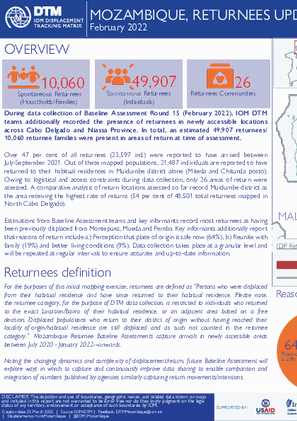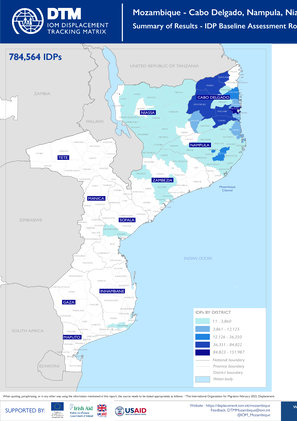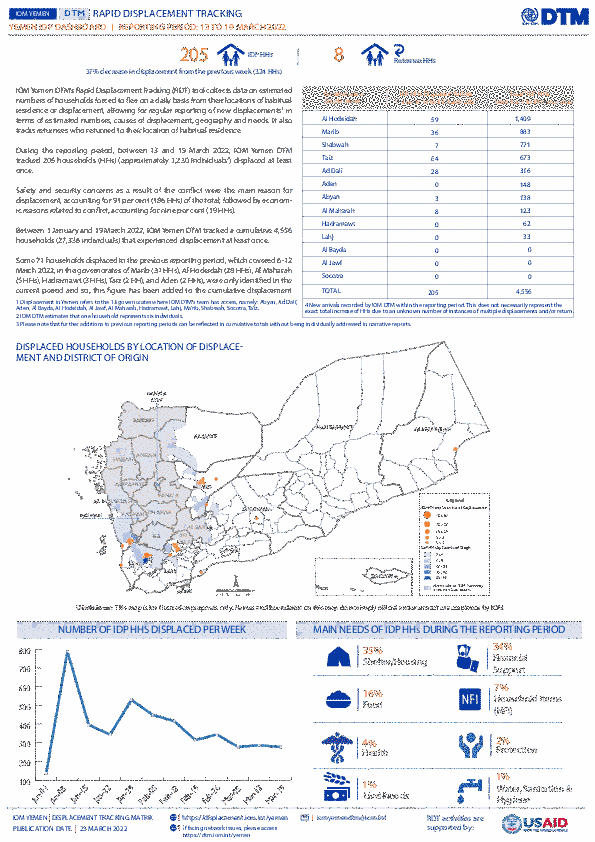-
Countries
-
Data and Analysis
-
Special Focus
-
Crisis Responses
Contact
DTM Mozambique, DTMMozambique@iom.int
Location
Mozambique
Activity
- Mobility Tracking
- Baseline Assessment
Period Covered
Feb 01 2022 -Feb 28 2022
A baseline assessment is a sub-component of mobility tracking. It aims to collect data on IDP, migrant or returnee population presence in a defined administrative area of the country.
Population Groups
Survey Methodology
Unit of Analysis Or Observation
Type of Survey or Assessment
Keywords
Geographical Scope
Administrative boundaries with available data
The current dataset covers the following administrative boundaries

Contact
DTM Mozambique, DTMMozambique@iom.int
Language
English
Location
Mozambique
Period Covered
Feb 01 2022
Feb 28 2022
Activity
- Mobility Tracking
During data collection of Baseline Assessment Round 15 (February 2022), IOM DTM teams additionally recorded the presence of returnees in newly accessible locations across Cabo Delgado and Niassa Province. In total, an estimated 49,907 returnees/10,060 returnee families were present in areas of return at time of assessment.
Over 47 per cent of all returnees (23,597 ind.) were reported to have arrived between July-September 2021. Out of these mapped populations, 21,487 individuals are reported to have returned to their habitual residences in Muidumbe district alone (Miteda and Chitunda posto). Owing to logistical and access constraints during data collection, only 26 areas of return were
assessed. A comparative analysis of return locations assessed so far record Muidumbe district as the area receiving the highest rate of returns (54 per cent of 48,501 total returnees mapped in North Cabo Delgado).

Contact
DTM Mozambique, DTMMozambique@iom.int
Language
English
Location
Mozambique
Period Covered
Feb 01 2022
Feb 28 2022
Activity
- Mobility Tracking
Increased security incidents in northern Mozambique since 2017 resulted in population displacement as well as subsequent humanitarian needs. To better understand the scope of displacement trends and needs of displaced populations, the
International Organization for Migration (IOM) activated DTM in Cabo Delgado province in February 2019. This summary presents initial fndings the 15th round of Baseline Assessments monitoring displacements triggered by conflict in Northern Mozambique. Key-informant interview were conducted at district and location-level between January and February 2022.
Assessments estimate the presence of 784,564 internally displaced persons (IDPs) mapped across displacement sites and
host communities in 208 localities. Security and access restraints in the districts of Nangade, Macomia, Meluco, Mocimboa da Praia, Quissanga, Muidumbe and Palma, have limited data collection to select localities accessible to DTM held teams and focal points.
For this round, 28% of 784,564 IDPs are mapped in relocation sites, temporary centers and host community extensions. One-fitth of total IDPs present at the time of assessment were mapped in Pemba (151,987 individuals), followed by Metuge (124,036 individuals), Mueda (84,822 individuals), Ancuabe (72,526 individuals) and Nangade (64,866 individuals).

Contact
DTM Ethiopia, SLOAddisAbabaDTM@iom.int
Language
English
Location
Ethiopia
Period Covered
Feb 01 2022
Feb 28 2022
Activity
- Flow Monitoring
In February 2022, a total of 18,683 movements were observed across five of Ethiopia's flow monitoring points (FMPs). It should be noted that data collection at Humera Flow Monitoring Point in Tigray region did not take place due to security and access constraints, thus affecting the total number of movements for the month. This represents an 6% increase in daily average movements in comparison with January 2022 when an average of 630 movements per day were observed.

Contact
DTM Mauritania, dtmmauritania@iom.int
Language
French
Location
Mauritania
Period Covered
Mar 07 2022
Mar 10 2022
Activity
- Mobility Tracking
- Event Tracking
- Village Assessment
Le suivi des situations d’urgence (en anglais, Emergency Tracking Tool, ETT) est une des composantes de la Matrice de suivi des déplacements (DTM) déployée par l’Organisation Internationale pour les Migrations (OIM). Il a pour objectif de recueillir des informations relatives aux déplacements causés par une crise ou des évènements soudains. Il offre une évaluation préliminaire d’une situation et permet de rapidement mettre en œuvre des mécanismes de réponse.
Le 05 mars 2022, suite à des attaques perpétrées par des individus armés dans la localité d’Attaye qui se trouve dans la commune de Dogofri (cerle de Niono, dans la région de Ségou au Mali), 857 familles d’éleveurs mauritaniens (4 426 individus) ont fui la commune et sont retournées, de manière préventive et par crainte d'attaques subséquentes, vers les villages de Likhleyil, Rkhoukha, Echleiba, Kervi, Teydouma et Seredouba en Mauritanie.
Les informations ont été collectées auprès d’informateurs clés (représentants de retournés, comités villageois) au moyen d’un questionnaire structuré axé sur les déplacements et les besoins humanitaires multisectoriels.

Contact
DTM Nigeria, AllUsersInDTMNigeria@iom.int
Language
English
Location
Nigeria
Period Covered
Mar 14 2022
Mar 20 2022
Activity
- Event Tracking
- Mobility Tracking
The DTM Emergency Tool (ETT) is deployed to track and to collect information on large and sudden population movements, provide frequent updates on the scale of displacement and quantify the affected population when needed. As a sub-component of the Mobility Tracking methodology in Nigeria. ETT utilises direct observation and a broad network of key informants to capture best estimates of the affected population per location, enabling targeted humanitarian response planning.
Between 14 and 20 March 2022, a total of 2,422 movements were recorded in Adamawa and Borno States. The recorded movements consisted of 2,053 arrivals and 369 departures. Arrivals were recorded at locations in Askira/Uba, Bama, Biu, Damboa, Gwoza, Hawul, Kala/Balge and Ngala Local Government Areas (LGAs) of the most conflict-affected state of Borno and in Fufore, Girei, Gombi, Hong, Lamurde, Maiha, Michika, Mubi South, Song, Yola North and Yola South LGAs of Adamawa State.
Departures were recorded in Askira/Uba, Bama and Gwoza LGAs of Borno State and in Fufore, Gombi, Hong, Maiha, Michika, Mubi North, Mubi South, Song, Yola North and Yola South LGAs of Adamawa State. ETT assessments identified the following movement triggers: voluntary relocation (843 individuals or 35%), poor living conditions (522 individuals or 22%), conflicts/attacks (459 individuals or 19%), military operations (341 iindividuals or 14%), improved security (186 individuals or 8%), fear of attacks (37 individuals or 1%) and seasonal farming (34 individuals or 1%).

Contact
DTM Yemen, iomyemendtm@iom.int
Language
English
Location
Yemen
Period Covered
Mar 13 2022
Mar 19 2022
Activity
- Rapid Emergency Registration
- Mobility Tracking
IOM Yemen DTM’s Rapid Displacement Tracking (RDT) tool collects data on estimated numbers of households forced to flee on a daily basis from their locations of origin or displacement, allowing for regular reporting of new displacements in terms of estimated numbers, geography, and needs. It also tracks returnees who returned to their location of origin.
From 01 January 2022 to 19 March 2022, IOM Yemen DTM tracked 4,556 households (HHs) (27,336 Individuals) have experienced displacement at least once.
Between 13 and 19 March 2022, IOM Yemen DTM tracked 205 households (1,230 individuals) displaced at least once. The majority of people moved into/within the following governorates and districts:
- Taiz (64 HHs) – Jabal Habashi (60 HHs), Al Makha (3 HHs), Al Qahirah (1 HH) and other districts. Most displacements in the governorate were internal.
- Al Hodeidah (59 HHs) – Hays (49 HHs), Al Khukhah (10 HHs) districts. Most displacements in the governorate were internal.
- Marib (36 HHs) – Marib City (20 HHs), Marib (11 HHs), Harib (5 HHs) districts. Most displacements in the governorate originated from Marib with 47 percent arriving from nine other governorates.
The majority of people moved from the following governorates and districts:
- Taiz (75 HHs) – Jabal Habashi (60 HHs), Maqbanah (6 HHs), Sharab Ar Rawnah (2 HHs) and other (7 HHs) districts.
- Al Hodeidah (63 HHs) – Hays (37 HHs), Jabal Ras (10 HHs), Al Jarrahi (6 HHs) and other (10 HHs) districts.
- Marib (19 HHs) – Harib (9 HHs), Jabal Murad (4 HHs), Marib City (3 HHs) and other (3 HHs) districts.
Contact
DTM Yemen, iomyemendtm@iom.int
Location
Yemen
Activity
- Event Tracking
- Mobility Tracking
Period Covered
Mar 13 2022 -Mar 19 2022
From 01 January 2022 to 19 March 2022, IOM Yemen DTM tracked 4,556 households (HHs) (27,336 Individuals) have experienced displacement at least once.
Between 13 and 19 March 2022, IOM Yemen DTM tracked 205 households (1,230 individuals) displaced at least once. The majority of people moved into/within the following governorates and districts:
• Taiz (64 HHs) – Jabal Habashi (60 HHs), Al Makha (3 HHs), Al Qahirah (1 HH) and other districts. Most displacements in the governorate were internal.
• Al Hodeidah (59 HHs) – Hays (49 HHs), Al Khukhah (10 HHs) districts. Most displacements in the governorate were internal.
• Marib (36 HHs) – Marib City (20 HHs), Marib (11 HHs), Harib (5 HHs) districts. Most displacements in the governorate originated from Marib with 47 percent arriving from nine other governorates.
The majority of people moved from the following governorates and districts:
• Taiz (75 HHs) – Jabal Habashi (60 HHs), Maqbanah (6 HHs), Sharab Ar Rawnah (2 HHs) and other (7 HHs) districts.
• Al Hodeidah (63 HHs) – Hays (37 HHs), Jabal Ras (10 HHs), Al Jarrahi (6 HHs) and other (10 HHs) districts.
• Marib (19 HHs) – Harib (9 HHs), Jabal Murad (4 HHs), Marib City (3 HHs) and other (3 HHs) districts.
Population Groups
Survey Methodology
Unit of Analysis Or Observation
Type of Survey or Assessment
Keywords
Geographical Scope
Administrative boundaries with available data
The current dataset covers the following administrative boundaries

Contact
DTMMozambique@iom.int
Language
English
Location
Mozambique
Period Covered
Mar 23 2022
Mar 23 2022
Activity
- Event Tracking
- Mobility Tracking
Recent movements of Non-State Armed Groups (NSAGs) have been reported in Mueda district. As of 23 March, observed presence of NSAGs in Mocimboa do rovuma and Naida areas triggered four large IDP arrival movements recorded in Namaua, Natsenge and Ngapa. An estimated 634 individuals have arrived in host communities and displacement sites of Imbuo and N'gapa posto. From the total individuals reported 33 have been identified with vulnerabilities: 24 elderly individuals and 9 pregnant women.

Contact
DTMMozambique@iom.int
Language
English
Location
Mozambique
Period Covered
Mar 16 2022
Mar 22 2022
Activity
- Event Tracking
- Mobility Tracking
During the reporting period (16 to 22 March 2022), a total of 42 movements were recorded - 35 Arrivals (1,348 individuals), and 7 departures (491 individuals). The largest arrival movements were recorded in Nangade (723 individuals), Mueda (457 individuals), and Montepuez (63 individuals). The largest departures were observed in Ancuabe (276 individuals) and Nangade (167 individuals). Of the total population, 73 per cent of the mobile groups were displaced for the first time, and 27 per cent of reported to having been displaced more than once prior to this movement.